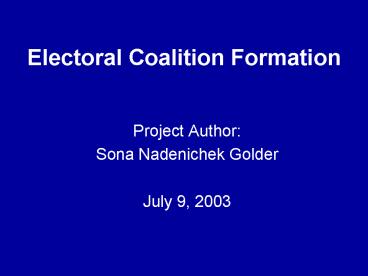Electoral Coalition Formation PowerPoint PPT Presentation
1 / 11
Title: Electoral Coalition Formation
1
Electoral Coalition Formation
- Project Author
- Sona Nadenichek Golder
- July 9, 2003
2
What Is an Electoral Coalition?
- In this study, denotes platform-like
- announcement by party headquarters
- During parliamentary election campaign,
- parties declare intent to govern together
- In district-based electoral systems,
- may involve joint coalition candidacies
3
Electoral Coalitions are Important . . .
- They shape electoral outcomes
- They clarify voters choices
- They precede 1 in 4 governing coalitions
4
Electoral Coalitions are Important . . .
- They shape electoral outcomes
- They clarify voters choices
- They precede 1 in 4 governing coalitions
- . . . But No One Studies Them
5
Electoral Coalition Model
- two strategic parties (A and B)
- one non-strategic party (Opp)
- winning joining post-election government
- coalition ? joint A-B campaign against Opp
- distinct ? three camps run distinct campaigns
6
Coalition Formation Game
- coalition
coalition - accept
accept - offer counter
- A B A
-
- distinct
distinct -
coalition -
accept - offer
- B A
-
- distinct
distinct
7
When Will the Coalition Form?
- When coalition can offer each party more than
its reservation value (distinct payoff) - Payoffs based on generic pb expressions
- p probability of winning
- b office and policy benefits
8
Coalition is More Likely . . .
- the closer A and B are (ideologically)
- the farther A (or B) is from Opp (if coalition
offers better odds of winning than distinct) - the higher a coalitions odds of winning
- the lower As (or Bs) distinct odds of winning
- the smaller As (or Bs) distinct office
benefits
9
Probit Coalition Propensity
- ?1 AB policy distance
- ?2 polarization ?3 ln(avg. magnitude)
- ?4 polarization ln(avg. magnitude)
- ?5 AB current seats
- ?6 (AB current seats)2
- ?7 percent upper tier seats
- ?8 disparity in A and B current seats
- ?0 ?
10
Among Dyads, Coalitions are Rare
- 74 of coalitions are two-party
- this tractability ? dyadic data
- among 4711 dyads
- (21 industrialized democracies
- 293 total election years),
- 238 (5) saw electoral coalitions
11
Results Support Hypotheses
- all model-derived coefficients are
significant with proper sign - increasing single variable value from mean to
one standard dev. higher - ? coalition likelihood increases between 5
and 187 percentage points

